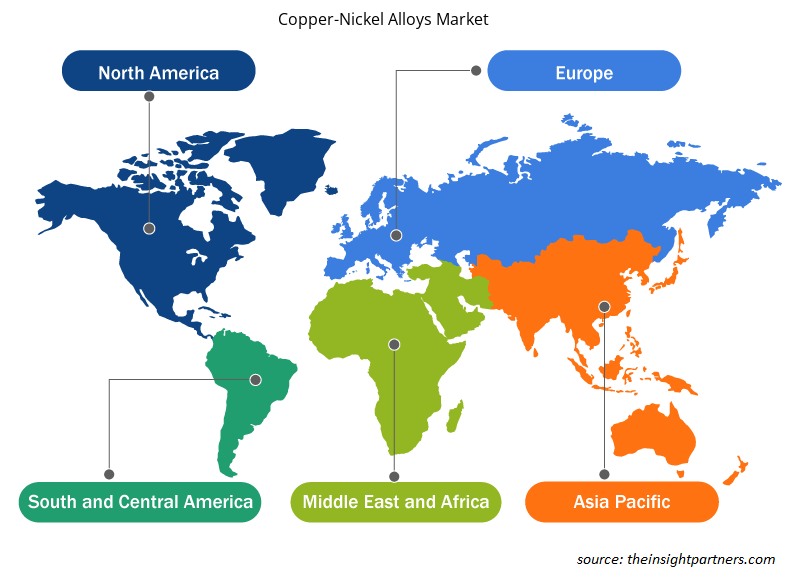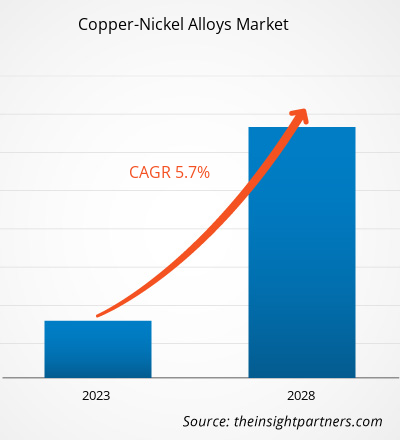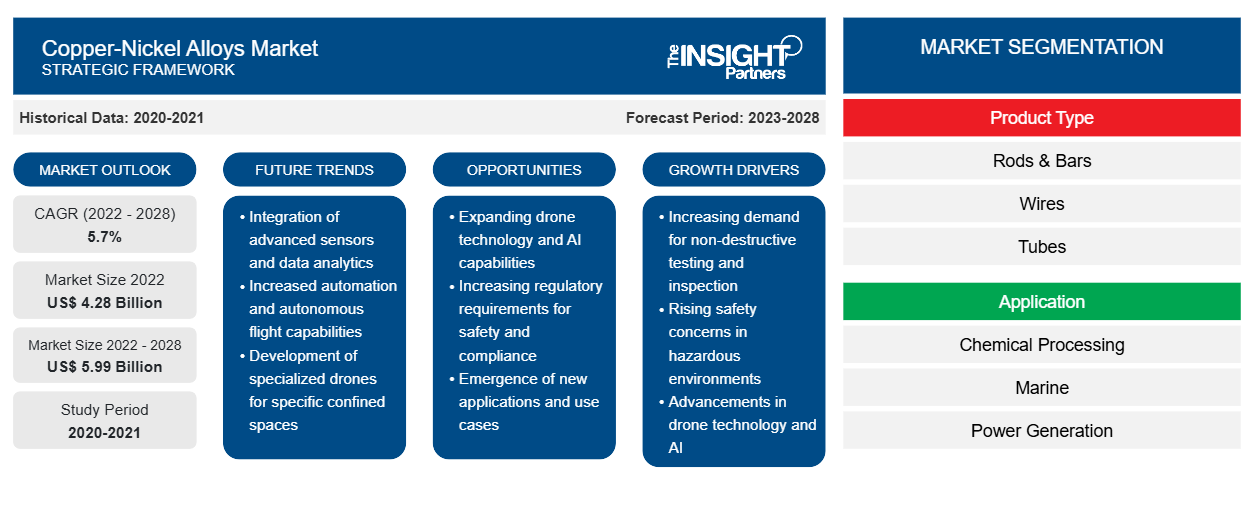到 2028 年,铜镍合金市场规模预计达到 59.8937 亿美元;预计 2022 年至 2028 年的复合年增长率 (CAGR) 为 5.7%。
铜镍合金具有出色的耐腐蚀性。由于表面形成了保护性氧化层,它们还表现出抗宏观污垢的能力。铜镍合金通常有两种:Cu-Ni(90-10)和Cu-Ni(70-30)。Cu-Ni(70-30)合金比Cu-Ni(70-30)更坚固,并且具有更强的抗腐蚀(由海水引起)和抗宏观污垢的能力。但是,Cu-Ni-(90-10)比Cu-Ni(70-30)更便宜,并且在许多最终用途应用中具有更长的使用寿命。铜镍合金在海洋、化学加工、发电和石油天然气行业的需求强劲,这主要推动了铜镍合金市场的增长。
定制此报告以满足您的需求
您可以免费定制任何报告,包括本报告的部分内容、国家级分析、Excel 数据包,以及为初创企业和大学提供优惠和折扣
-
获取此报告的关键市场趋势。这个免费样品将包括数据分析,从市场趋势到估计和预测。
COVID-19 疫情对铜镍合金市场的影响
新冠疫情爆发后,各国政府实施的社会和商业限制措施导致供应链(包括进出口业务)严重中断,进而影响了原材料价格并阻碍了造船业的运营。石油和天然气行业也受到了疫情的类似影响,因为 2020 年原油需求出现了前所未有的下降,导致原油价格大幅下跌。根据美国劳工统计局的数据,2020 年石油需求减少了 300 万桶/日,约占美国整体石油消费量的 20%。因此,新冠疫情对海运和石油天然气行业造成了严重影响,对铜镍合金的需求产生了不利影响。此外,由于制造单位关闭,铜镍合金的生产暂停,这影响了小型和大型制造商的盈利能力。
2021 年,各国政府宣布放宽先前实施的限制,并允许制造商满负荷生产。因此,铜镍合金制造商修改了提高产量的策略,有望克服产量不足和供需缺口。预计这一因素将在预测期内推动全球铜镍合金市场的发展。
市场洞察
可再生能源项目中铜镍合金的采用激增,为铜镍合金市场带来新的增长趋势
各国政府都在鼓励人们使用可再生能源,以减少对环境的整体影响。涡轮机、桨叶、热交换器(在聚光太阳能 CSP 系统中)、风能涡轮机以及可再生能源发电中使用的许多组件都是由铜镍合金制成的。根据国际能源署 (IEA) 的数据,2020 年全球可再生能源的使用增长了 3%。可再生能源在全球发电中的份额从 2019 年的 27% 达到 2020 年的 29%。美国、欧盟 (EU)、中国和印度等国家正在采取各种举措,推动对清洁能源生产的投资,以保护环境和实现可持续的经济发展。例如,2022 年 3 月,欧盟制定了“REPowerEU 计划”,以生产清洁能源并节约能源,避免对俄罗斯化石燃料的依赖。 RePowerEU 计划旨在到 2030 年实现可再生能源总产量达到 1,236 千兆瓦。欧盟委员会表示,在 2022-2027 年期间实施 REPowerEU 计划将需要额外投资 2089.1 亿美元,预计这些资金将来自欧盟成员国和私营部门。预计不同国家的政府此类举措将在未来推动可再生能源行业的发展,进而促进铜镍合金市场的增长。
产品类型洞察
根据产品类型,全球铜镍合金市场细分为棒材、线材、管材和其他。棒材和棒材部分在 2021 年占据了最大的市场份额。铜镍圆棒因其独特的性能(例如抗宏观污垢、良好的抗拉强度和耐腐蚀性)而用于动力转向、制动管路、蒸馏器管、冷凝器板和压力容器。此外,镍含量为 10% 和 30% 的铜镍棒通常用于冷凝器、蒸馏器、蒸发器、热交换器管、机加工和锻造阀门以及用于海水服务的泵部件。
Corrotherm International Ltd、Fisk Alloy Inc、Lebronze Alloys SAS、Materion Corp、Aesteiron Steels LLP、Columbia Metals Ltd、American Elements Inc、Hexion Steel Ltd、Aviva Metals Inc 和 Kalikund Steel and Engg Co 是全球铜镍合金市场的主要参与者。该市场中的公司不断专注于投资研发活动和推出新产品等战略。
铜镍合金市场区域洞察
Insight Partners 的分析师已详尽解释了预测期内影响铜镍合金市场的区域趋势和因素。本节还讨论了北美、欧洲、亚太地区、中东和非洲以及南美和中美洲的铜镍合金市场细分和地理位置。

- 获取铜镍合金市场的区域特定数据
铜镍合金市场报告范围
| 报告属性 | 细节 |
|---|---|
| 2022 年市场规模 | 42.8亿美元 |
| 2028 年市场规模 | 59.9 亿美元 |
| 全球复合年增长率(2022 - 2028) | 5.7% |
| 史料 | 2020-2021 |
| 预测期 | 2023-2028 |
| 涵盖的领域 |
按产品类型
|
| 覆盖地区和国家 |
北美
|
| 市场领导者和主要公司简介 |
|
铜镍合金市场参与者密度:了解其对业务动态的影响
铜镍合金市场正在快速增长,这得益于终端用户需求的不断增长,而这些需求又源于消费者偏好的不断变化、技术进步以及对产品优势的认识不断提高等因素。随着需求的增加,企业正在扩大其产品范围,进行创新以满足消费者的需求,并利用新兴趋势,从而进一步推动市场增长。
市场参与者密度是指在特定市场或行业内运营的企业或公司的分布情况。它表明在给定市场空间中,相对于其规模或总市场价值,有多少竞争对手(市场参与者)存在。
在铜镍合金市场运营的主要公司有:
- Corrotherm 国际有限公司
- 菲斯克合金公司
- 青铜合金公司
- Materion 公司
- 埃斯特钢铁有限责任公司
免责声明:上面列出的公司没有按照任何特定顺序排列。

- 了解铜镍合金市场顶级关键参与者概况
报告亮点
- 铜镍合金市场的渐进式行业趋势可帮助参与者制定有效的长期战略
- 公司为在发达市场和发展中市场扩张而采用的业务增长战略
- 2020 年至 2028 年铜镍合金市场定量分析
- 全球铜镍合金需求量估计
- 波特五力分析说明行业中买家和供应商的效力
- 了解竞争市场状况的最新发展
- 铜镍合金市场的市场趋势和展望以及驱动因素和限制因素
- 通过强调支撑商业利益的市场策略来协助决策过程
- 不同节点铜镍合金市场规模
- 市场详细概述和细分,以及铜镍合金行业动态
- 各地区铜镍合金市场规模及增长潜力分析
公司简介
- Corrotherm国际有限公司
- 菲斯克合金公司
- 青铜合金公司
- Materion 公司
- 埃斯特钢铁有限责任公司
- 哥伦比亚金属有限公司
- 美国元素公司
- 汉森钢铁有限公司
- 英杰华金属公司
- 卡利昆德钢铁工程公司
- 历史分析(2 年)、基准年、预测(7 年)及复合年增长率
- PEST和SWOT分析
- 市场规模、价值/数量 - 全球、区域、国家
- 行业和竞争格局
- Excel 数据集
近期报告
相关报告
客户评价
购买理由
- 明智的决策
- 了解市场动态
- 竞争分析
- 客户洞察
- 市场预测
- 风险规避
- 战略规划
- 投资论证
- 识别新兴市场
- 优化营销策略
- 提升运营效率
- 顺应监管趋势























 获取免费样品 - 铜镍合金市场
获取免费样品 - 铜镍合金市场